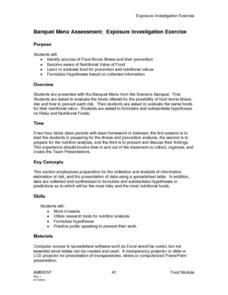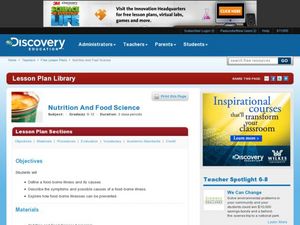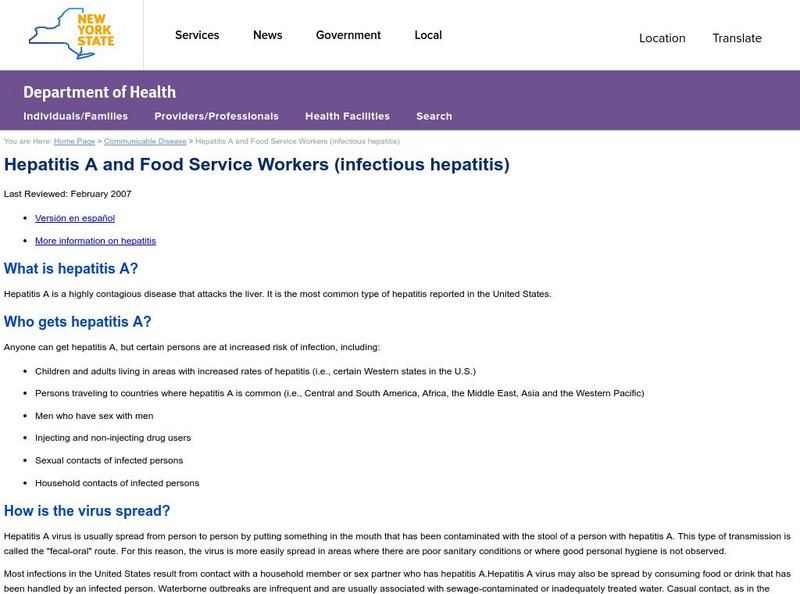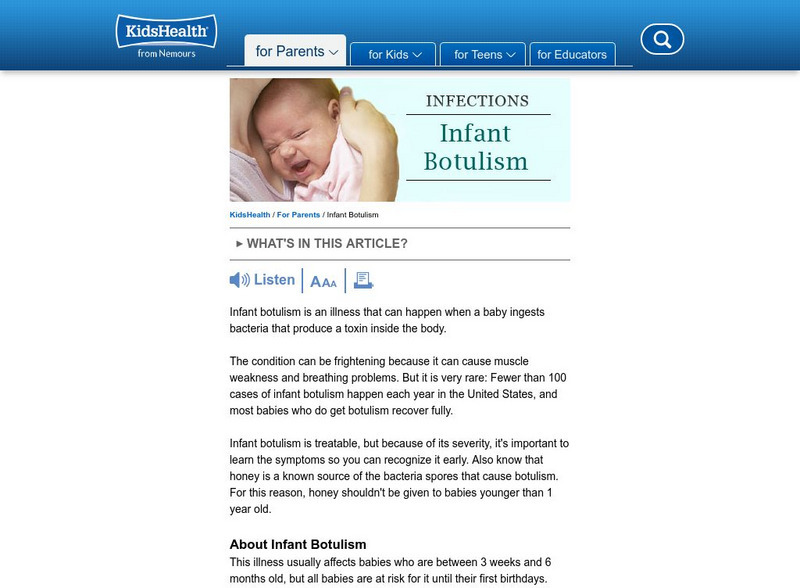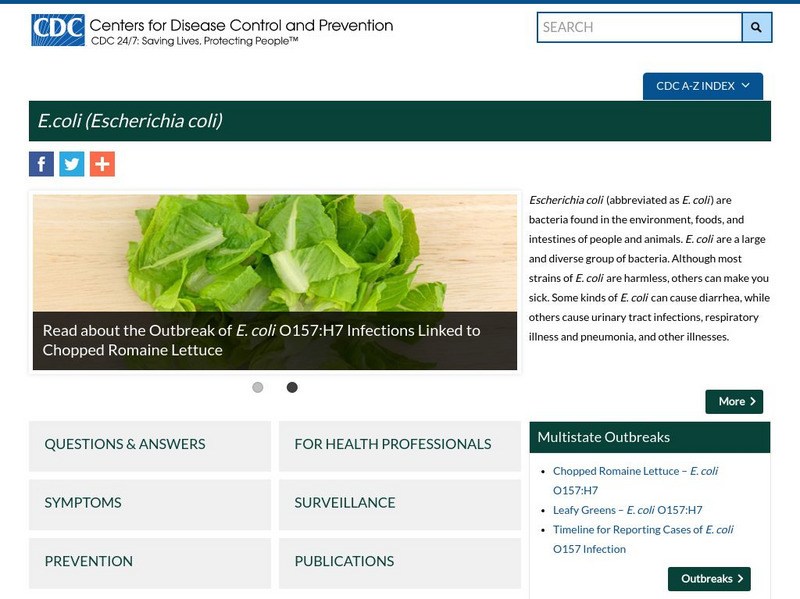University of Rhode Island
Food Safety Smart Curriculum
This is a must-have resource with everything you'll need for studying food safety with your pupils. From handwashing scorecards and cleaning kitchen surfaces to navigating the world of microbes and food-borne illnesses,...
National Library of Medicine
Your Environment, Your Health: Food Safety
Did youknow that chicken causes the greatest risk of food-borne illness. The fourth unit in a six-part series addresses food safety. Scholars research common scenarios of food causing illness through the National Institute for Health....
Curated OER
Raw Seafood ~ On the Half Shell
The topic is fascinating, but there is not much for learners to do here. Food borne illness has always been a problem for humans to face, and here, data from the Center for Disease Control is analyzed. Learners look at the number of...
Curated OER
Banquet Menu Assessment: Exposure Investigation Exercise
Students identify sources of Food Borne illness and their prevention. They formulate hypotheses based on collected information. Pupils become aware of Nutrintional value of food. Students collected data are synthesized to formulate...
Curated OER
Food Myths Critical Thinking and Reading
Students read a series of statements made by students about the hazards and benefits of various foods. They distinguish the "facts: from "opinions" in the dialogue, summarize the facts in a short paragraph, and write an essay...
Curated OER
Bacteria and Illness
High schoolers research information on bacterium and their relationship to food borne diseases. In this science lesson plan, students complete internet research to construct and analyze the growth cure of common bacterium...
Curated OER
Kitchen Inspection Exercise
Young scholars use a Department of Health Inspection Form to evaluate a kitchen/food prepartion facility as individuals or teams. They research prevention of food born illness during food storage and food preparation including Hazard...
Curated OER
Nutrition and Food Science
Learners examine the causes and symptoms of food-borne illnesses and ways to prevent them. In this nutrition lesson plan students work in teams to investigate a type of food-borne illness and present a scenario about it.
Curated OER
Chapter 16, Food Biotechnology
Although the points given on these slides are valid, the visual accessibility is poor. Consequently, many viewers would be distracted or entirely unable to view the presentation. The content is a review of microorganisms and their...
Curated OER
4-H Food Science- Intermediate Activity
In this nutrition worksheet set, students complete a dinner detective nutrient fill in the blank, a food safety true or false page, and plan a picnic with food safety rules in mind. They investigate careers that involve food safety.
Curated OER
Bacteria
Students study food borne illnesses and what foods are more likely to carry them. In this investigative instructional activity students examine harmful bacteria.
Curated OER
Food Preservation
Students examine the different food canning methods and how to be safe canning. In this canning lesson students examine the hazards of improperly canning.
Curated OER
Regulation and handling of animal products: a special challenge
Students examine how food safety affects sustainable animal production and marketing. In this agriculture lesson plan students complete several activities including one on groceries and the rules of animal products.
Curated OER
How Did That Get in My Lunch?
Young scholars view "The Danger Zone" to learn about food poisoning and the bacterial causes and prevention. Students look at slides, use a worksheet, "Microbial Bugs"and the internet to identify and learn about each bacterium.
Curated OER
Epidemic, Plague, and Infection
Students investigate the illness borne in concentration camps. In this Holocaust lesson, students participate in a simulation that requires them to consider how ailments became epidemics in concentration camps.
American Institute of Biological Sciences
Action Bioscience: Investigating Food Borne Illness
Familiarize yourself with various food-bourne illnesses and the negative impacts they can have on consumers.
New York State Dept. of Health
New York State Health Dept.: Hepatitis a & Food Service
A fact sheet about Hepatitis A with a focus on food service workers and personal hygiene practices.
Other
Virginia State Department of Agriculture/consumer Sciences: About Food Poisoning
This site about food poisoning discusses Staphylococcus Aureus - what it is, where the common sources of "staph" are, common symptoms, and what can be done to prevent contamination and infection.
US Food and Drug Administration
Fda: Clostridium Perfringens
Extensive information about the germ clostridium perfringens and associated food poisoning.
Curated OER
Kids Health: Infant Botulism
Site provides an excellent description of botulism and how it affects infants, including information about symptoms, prevention and treatment.
Centers for Disease Control and Prevention
Centers for Disease Control: e.coli
Answers to the most frequently asked questions about E.coli.
Centers for Disease Control and Prevention
Centers for Disease Control: Salmonella
This resource general information including the most frequently asked questions about salmonella. Also technical information and links to articles about outbreaks.
Centers for Disease Control and Prevention
Centers for Disease Control: Viral Hepatitis a Fact Sheet
Great overview of the facts surrounding Hepatitis A. Presented in a very clear format. Click on the PDF to download.
US Department of Agriculture
Usda: Dangers of Buffets
Buffets can be breeding grounds for germs causing foodborne illness. Clostridium Perfringens is commonly referred to as "cafeteria germ" due to prolonged exposure at incorrect temperatures. Read how to protect yourself.
Other popular searches
- Food Borne Illnesses
- Food Borne Illness Project
- Bacteria Food Borne Illness
- Food Borne Illness Worksheet
- Food Borne Illness Module
- Lessons on Food Borne Illness
- Moral of Food Borne Illness
- Learn of Food Borne Illness
- Food Borne Illnesses Exam
- Avoiding Food Borne Illnesses



